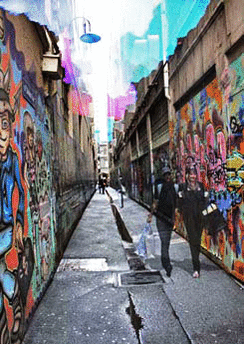[META]PHYSICAL GRAFFITI
Architect . Jean-Paul Rollo with Romas Kesminas and Danius Kesminas / Proposal . Laneways Commission 2010 - Shortlisted
“Oh! Oh! Oh, this is fantastic, Billy!...It’s going to fly away! It’s like a movie! Fantastic! This is one of the most exciting things that’s ever happened to me! It is so beautiful. Oh, Billy, it’s infinite, because it goes in with the sky. Oh, it is fantastic! Oh!...Billy, do you know what our movies are called? Up movies, and up art.” – Andy Warhol in conversation with Billy Klüver about Silver Clouds (1966)
[META]PHYSICAL GRAFFITI, has been specifically researched and developed for Union Lane in the heart of the city linking Bourke Street Mall and Little Collins Street between Swanston and Elizabeth Streets.
Framed by the David Jones Building to the east and the Walk Arcade Centre to the west, the narrow lane is a long dramatic slice revealing the remnants of its history and the skyline above. In the late 19th Century Union Lane was a centre of relatively high-value production occupied by electroplaters, brass finishes, locksmiths, an engraver and lapidary, a stereotyper, a wholesale newsagent and a watchmaker. It currently contains several functioning loading bays servicing the businesses in the neighbouring buildings. Today the lane is most notable for its murals of graffiti art and has a City of Melbourne street art permit.
[META]PHYSICAL GRAFFITI responds to the formal characteristics of Union Lane and its current function as an eminent showcase for graffiti and street art. Our scheme involves a suspended series of over-scale models of pressurised aerosol canisters (approximately 2 metres in height) fabricated in aluminium and transparent acrylic. The canisters house customised fog machines that reference the disused capillary network of cast-iron sullage pipes on the west wall, like the impossible “ship in a bottle”. Choreographically sequenced, they intermittently emit a fine scented painterly mist that temporarily envelops the space before dissipating. At the system’s culmination the aerosols would be Obscured by Clouds, wedged in the lane, creating a synaesthetic kaleidoscope of atmosphere, colour and perfume. The sound of an aerosol can would be sampled and amplified, including the rhythmic rattle of the ball bearing stirring the propellant and paint providing a cue for the commencement of the cycle signalled by the sound of the spray emanating from the valve/nozzle. The completed cycle from resting position to the formation of fully formed graffiti clouds before dissipating to nothing takes approximately 2 hours. The event could take place several times over a 24 hour period.
More than simply a tribute to the graffiti artists and crews responsible for advancing Melbourne’s current reputation as an international street art capital, this installation of performative thought bubbles forces the viewer to apprehend the historical traces of the buildings above and the skyline beyond and generates boundless connotations. The 3 dimensional cloud wedges are a seemingly meteorological condensation of painting. Liberated Off the Wall, [META]PHYSICAL GRAFFITI provides a Union between the lane and the sky, the profane and the sacred. The floating rectangles of Andy Warhol’s Silver Clouds (1966) are an obvious art historical companion to our suspended canisters. Warhol’s pillows of metallised plastic film filled with a mixture of helium and oxygen were an embodiment of his “farewell to painting”, a physical manifestation of his desire for painting to leave the walls and float away.
Essentially optimistic in the sense of Milton’s proverb that “every cloud has a silver lining”, this haze conjures an atmosphere of toxic aerosol paint vapour is perhaps an allegory of the damaged ozone layer, climate change more generally or simply Melbourne’s unpredictable weather. However, our spectacular installation of glycol fog is harmless and will be perfume scented temporarily transforming Union Lane into a glamorous catwalk parade further alluding to Melbourne’s reputation as a cosmopolitan fashion hub and the proximity of the lane to the fashion trade.
Our title, [META]PHYSICAL GRAFFITI, relates to the branch of philosophy that investigates principles of reality transcending those of any particular science. It is concerned with explaining the fundamental nature of being and the world and what relations these things bear to one another. Metaphysics attempts to clarify the notions by which people understand the world, including existence, objecthood, property, space, time, causality, and possibility. According to Arthur C. Danto, Warhol problematised metaphysics, embracing the public even as he forced intellectuals to rethink the meaning of aesthetics.
[META]PHYSICAL GRAFFITI also references the 6th album by the English rock band Led Zeppelin released in 1975. Whilst Physical Graffiti was coined by guitarist Jimmy Page to describe the physical and conceptual energy involved in producing the album, our proposal relates to Melbourne’s popular and sub-cultural history by theatrically invoking the rock’n’roll stagecraft of smoky inner-city music venues where Mi-Sex might have been performing Graffiti Crimes in the late 70’s and early 80’s (“Dripping in the night and drying in the sunshine”).
Text . Danius Kesminas
 |  |
|---|---|
 |  |
 |  |
 |  |
 |  |
 |

